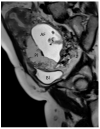Placental and Umbilical Cord Anomalies Diagnosed by Two- and Three-Dimensional Ultrasound
- PMID: 36428871
- PMCID: PMC9689386
- DOI: 10.3390/diagnostics12112810
Placental and Umbilical Cord Anomalies Diagnosed by Two- and Three-Dimensional Ultrasound
Abstract
The aim of this review is to present a wide spectrum of placental and umbilical cord pathologies affecting the pregnancy. Placental and umbilical cord anomalies are highly associated with high-risk pregnancies and may jeopardize fetal well-being in utero as well as causing a predisposition towards poor perinatal outcome with increased fetal and neonatal mortality and morbidity. The permanent, computerized perinatology databases of different international centers have been searched and investigated to fulfil the aim of this manuscript. An extended gallery of prenatal imaging with autopsy correlation in specific cases will help to provide readers with a useful iconographic tool and will assist with the understanding and definition of this critical obstetrical and perinatological issue.
Keywords: autopsy; perinatal outcome; placental pathology; three-dimensional ultrasound; two-dimensional ultrasound; umbilical cord pathology.
Conflict of interest statement
The authors declare no conflict of interest.
Figures


































References
-
- Rezende G.C., Araujo E., Jr. Prenatal diagnosis of placenta and umbilical cord pathologies by three-dimensional ultrasound: Pictorial essay. Med. Ultrason. 2015;14:545–549. - PubMed
-
- Ptacek I., Sebire N.J., Man J.A., Brownbill P., Heazell A.E.P. Systematic review of placental pathology reported in association with stillbirth. Placenta. 2014;5:552–562. - PubMed
-
- Hayes D.J.L., Warland J., Parast M.M., Bendon R.W., Hasegawa J., Banks J., Clapham L., Heazell A.E.P. Umbilical cord characteristics and their association with adverse pregnancy outcomes: A systematic review and meta-analysis. PLoS ONE. 2020;15:e0239630. doi: 10.1371/journal.pone.0239630. - DOI - PMC - PubMed
Publication types
LinkOut - more resources
Full Text Sources

